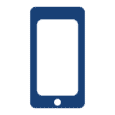Do you have a cell phone? Is it a smartphone? Chances are, it is. You’re likely using it all the time for a myriad of reasons—personal, business, and social networking. If you don’t, the reason may be the costs! Charges for buying a new cell device (with newer, more technologically-advanced models coming out seemingly all of the time) in addition to data plans, can quickly rack up to an astronomical amount. Fortunately for you, there are ways around the ever-increasing costs that are so frequently associated with cell phones—thanks to the Federal Lifeline Program, which has been in place since 1985 and is part of the Universal Service Fund. Due to this government-funded program aimed at assisting low-income consumers, a cell phone, data plan, and/or broadband internet service can be yours for little to no cost. It all depends on a few qualifying factors. Want to learn more about free government cell phones/free smartphones and how Assist Wireless can help? Read on!
We’re here to let you in on a little secret. Well, eight of them to be exact! Everyone in need deserves to be brought up-to-speed on this amazing opportunity. No one should have to go without a smartphone, data or messaging services due to their economic hardships. If you are in a financially-strained situation, let us put your mind at ease. Assistance is really easier and more within reach than you think.
Here are some surprising facts about free government cell phone plans that you probably didn’t know—and you’ll be so glad you do now!
- You can qualify by your income or participation in certain programs—If your household income falls into a certain bracket (135% or less than the Federal Poverty Guidelines), you can take advantage of this free government phone service opportunity. Another way to qualify is if you are a recipient of funds dispersed by Medicaid, Supplemental Nutrition Assistance Program (SNAP), Supplemental Security Income (SSI), Federal Public Housing Assistance (FPHA), Veterans Pension & Survivors Benefits, Tribally Administered Temporary Assistance for Needy Families (TANF), Food Distribution Program on Indian Reservations (FDPIR), or an Award Letter for Clothing, Shelter, or Utilities from Bureau of Indian Affairs General Assistance (BIA). The most popular way is to get free service and a free phone with food stamps. As you can see, qualifications are open to reach a wide range of people in different circumstances.
- Providing proof will speed up and certify your eligibility—if you meet the requirements via income or program participation, there are a number of documents you can submit as proof of your eligibility. Provide your proof and—poof! Your new cell phone will finally be within reach. Go ahead and get ahold of any of the following documents to submit:
- Veterans Administration Benefits Statement
- Prior year’s State, Federal, or Tribal Tax Return
- Retirement/Pension Benefits Statement
- Social Security Benefits Statement
- Unemployment/Workers Compensation Benefits Statement
- Divorce Decree or Child Support Documents
Head to https://www.assistwireless.com/, fill out the application, submit your paperwork, and receive your new phone!
- Assist Wireless offers more than just a free phone and service. Assist Wireless is the #1 Oklahoma Lifeline provider for a reason! Some of the additional perks and promotions they offer include the ability to get up to 4GB FREE every month when you qualify for Lifeline service in Oklahoma, birthday and activation date anniversary rewards, and a variety of ways to earn free account credits.
- There are over 30 locations in Oklahoma waiting to help you. Assist Wireless currently conducts business in 30 retail locations and offers free cell phone service in Oklahoma, Arkansas, Maryland, and Missouri. In addition to visiting one of their stores, you can also call, chat live, or email a member of their first-rate customer service team to get started now. Plus, if you run out of minutes, texts, or data, don’t worry! It can be easy to do while chatting with family and friends, participating in virtual meetings with coworkers, corresponding via emails, or catching up on your social media accounts. Fear not—Assist Wireless has your back. You can simply “refill” your account at a great, discounted rate in no time. You can reload with 1 GB of data for just $15.
- Assist Wireless offers several plans to meet your needs. The customer service team recognizes that there isn’t a “one size fits all” package to satisfy all of their customers. People from all different lifestyles have unique needs when it comes to cellular phones, minutes and data plans. There are a variety of phones and talk/text/data plans for you to choose from.
- You can get a hearing-impaired device. Assist Wireless serves a diverse span of clientele from all walks of life and with differing special needs. This caring company truly recognizes that hearing-impaired customers need and deserve an affordable cell phone and plan as well. They are proud to offer these mobile devices. Inquire online/chat, by phone, or email for more information.

- How many free government phones can I get? Only one LifeLine benefit is permitted per household. Federal rules prohibit customers from receiving more than one Lifeline service. If a household currently enrolled with one of the other Lifeline phone service providers, they must de-enroll from other services immediately or be subject to penalties.
- You can KEEP your current phone! If you already have a cell phone you use and love, you can have it transferred to a Lifeline program with the “Bring Your Own Device” (BYOD) promotion. Once you qualify, representatives can check your phone’s IMEI number to see if it is compatible with the Assist Wireless networks. You can also check it out for yourself. In order to determine if your phone will work with a Lifeline program, you need to first make sure that it is unlocked. It must also be compatible with the following current Assist Wireless networks: GSM (T-Mobile) and CDMA (Sprint). Find your IMEI number in your phone’s settings, whether you presently have an iPhone, Android, or Windows device. Want more? You’ll also earn a $15 account credit or 1 GB of free data. That offer sounds pretty hard to beat!







